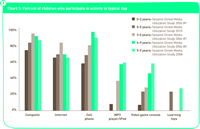
While children’s use of mobile media devices and computers is on the rise, they still use television as their primary media source, according to a report released March 14 by the Joan Ganz Cooney Center.
The report, entitled “Always Connected: The new digital media habits of young children,” examined media usage patterns in young children.
Almost nine out of 10 children over the age of five watch television at least three hours a day.
“Even as technology evolves and young children increasingly turn to games and mobile media, they still love television best,” the report said.
The center also found that media consumption patterns alter considerably around age eight, when children are developmentally able to participate in activities for longer and have more advanced motor skills.
Family income still acts as a barrier for owning media devices, with lower-income Hispanic and African American children consuming far larger amounts of media than their middle-class and white counterparts.
“While virtually every household in America owns a television, regardless of income or ethnicity, black and Hispanic children watch more TV than their white counterparts,” the study said.
One-third of respondents–most notably lower-income respondents–said their children’s media habits decreased with the 2008 economic downturn. Those lower-income participants reported an increase in reading printed books or magazines and less mobile-phone texting after 2008.
However, the report indicates that children’s exposure to and consumption of different types of digital media is growing rapidly.
“One of the big trends is the rise in popularity of portable media devices,” according to the report. “Children like their media to move with them.”
The report theorizes that the popularity increase is due to children wishing to imitate their parents and older siblings.
“There is also a wide range of new digital technologies available to children and their families. About two-thirds of families with children under age 11 have computers, and virtually every family that owns a computer has an internet connection. More than half have some type of video game system. And about three-quarters of families have cell phones,” the report notes.
Music consumption, in particular, illustrates how popular portable technologies have become.
“More than 90 percent of families own a radio, CD player or stereo. But there has been a 27 percent drop in ownership of stereos since 2005. At the same time, almost two-thirds of children now have an iPod or MP3 player, up from just 12 percent in 2004. The impact of new tablet media devices, such as the iPad, is unknown,” the report says.
“Increasing mobility means that children today can now consume media anytime and anyplace, which may account for increases in video-game play, listening to music, and watching videos over the last decade,” read the report.
Children also media multitask.
“Today, children ages 8 to 10 spend about 5.5 hours each day using media, but they’re actually exposed to almost 8 hours of media, because they use multiple media simultaneously,” the report said. Most of the multitasking occurs in conjunction with television.
Most children use the internet regularly, the report reveals.
Among very young children up to five years old who use the internet, “about 80 percent do so at least once a week. At age 3, about one-quarter of children go online daily, increasing to about half by age 5. And by age 8, more than two-thirds use the internet on any given weekday. Children ages 5-9 average about 28 minutes online daily. In 2009, the oldest children in our review (8-10) spent about 46 minutes on a computer every day. This is more than double the amount of time 8-to-10-year-olds spent online in 2006 (19 minutes).”
Children tend to gain more media exposure as they age, with the exception of electronic learning toys, which are educational aids separate from video or computer games.
“As they reach age 8, children are not only regularly using a wider selection of media, they are also more likely to personally own media devices,” the report said.
The report also notes that the educational potential for other mobile devices is increasing and mentions New York’s School of One as an example of a school using multiple media tools to engage students as they learn.
“The ubiquity of mobile technology may also allow for new breakthroughs in helping learners bridge different settings. Mobile devices help kids make connections between spheres of their everyday world, helping them link what they’re doing in school with what they do in after-school programs and at home. But more research is needed into how new technologies can be integrated into education,” according to the report.
The American Academy of Pediatrics, cited in “Always Connected,” recommends that children under age two should avoid watching television at all, and parents should limit the viewing time of older children to no more than two hours a day.
- New film fights negative perception of teachers - September 16, 2011
- Textbook-free schools share experiences, insights - September 7, 2011
- Social websites are latest sources for plagiarized material - September 1, 2011


Comments are closed.